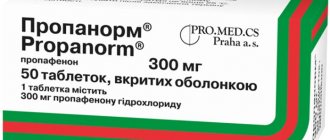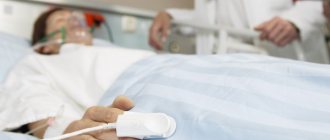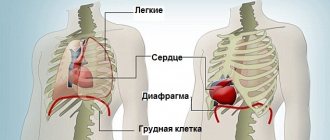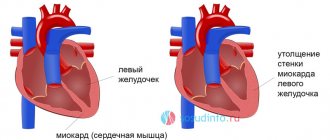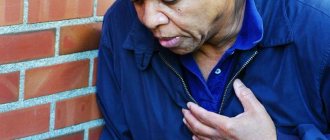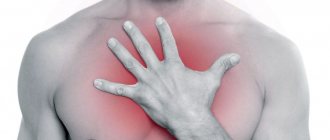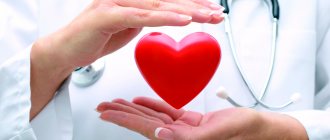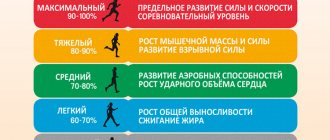Hello, friends!
If your heart hurts when running, this can be a dangerous symptom of a serious pathology. It is necessary to identify the nature of the pain in order to prevent serious health problems.
Chest pain that occurs during physical activity, including running, does not indicate heart problems. This syndrome can also occur with neuralgia, diseases of the respiratory or even digestive systems.
It is quite difficult to determine what actually hurts based on the nature of the pain, and not every doctor will undertake to summarize the cause of pain solely based on the patient’s complaints.
To clarify the causes of pain, it is necessary to use studies such as an ECG, so-called stress tests (ECG with stress), a general blood test, and, if necessary, gastroscopy.
Recently, echocardiography, an ultrasound technique for studying the functional and morphological state of the heart and its valve system, has been increasingly used.
If the pain is heart
Still, some cardiologists suggest remembering several distinctive features of real heart pain:
- most often it is dull or pulling, very rarely - sharp, sharp;
- the most common localization of heart pain is behind the sternum, that is, behind the central bone of the chest, under which the “heart sac” is located;
- it does not look like a lumbago that lasts for seconds and cannot last for several hours, for example, the average duration of pain during angina pectoris is 10 minutes;
- in most cases, breathing does not intensify heart pain (this can only happen in acute cases - with an aneurysm, myocardial infarction, coronary vasospasm);
- the muscle tissue over the source of cardiac pain is not painful.
In addition, heart pain is usually accompanied by changes in blood pressure. Therefore, if you experience pain in the heart while running, it is advisable to stop training, measure your pulse and, if possible, blood pressure and rest.
Causes of pain
Heart pain while running is mainly associated with pathological conditions. The causes may be functional or a symptom of an organic lesion. If the muscle tissue of the heart or coronary vessels is changed due to a pathological progressive process, then the supply of oxygen to the cells may decrease and pain in the heart may occur after running.
This occurs with dystrophic changes in the myocardium or coronary insufficiency. The following diseases are identified that cause discomfort in the chest:
- angina pectoris;
- congenital and acquired defects;
- heart rhythm disturbances;
- myocardial dystrophy;
- inflammatory lesions of the myocardium;
- aneurysms.
What diseases cause heart pain when running?
If a person has not experienced cardio for a long time, the heart will react with pain. When the chest hurts when running, this may be a signal that the heart cannot cope with pumping blood and the vessels are transporting an unusual volume of fluid. All together provokes the following diseases:
- intoxication of the body;
- thyroid diseases;
- metabolic imbalance;
- liver failure;
- hormonal imbalances;
- vitamin deficiency.
When the pain intensifies after a treadmill, this may indicate the presence of serious heart disease:
- myocardial dystrophy;
- cardiac ischemia;
- thrombophlebitis;
- atherosclerosis;
- hypertension;
- coronary spasm.
To avoid becoming a victim of improper running, it is necessary to undergo regular preventive examinations with a cardiologist or endocrinologist.
Loads need to be increased gradually so that the body gets used to it. You shouldn't run a marathon in one day because it's hard for your heart to cope with the overload.
Coronary insufficiency
As the name suggests, in coronary artery disease, blood flow in the coronary arteries stops partially or completely, thereby depriving the heart of the necessary amount of oxygen and nutrients.
This is a fairly common manifestation of coronary heart disease (CHD), which provokes heart attacks or sudden coronary death. It can occur in acute or chronic form and is a consequence of atherosclerotic vascular damage, which to one degree or another occurs in all people over 25 years of age.
With increased physical activity, the heart requires a huge supply of oxygen and nutrients. However, the vessels narrowed by the atherosclerotic process cannot provide the necessary blood flow to the heart, which leads to a lack of oxygen in the heart muscle and manifests itself in the form of pain. This type of coronary heart disease is called angina.
Dystrophic changes in the heart muscle
Overfatigue of the myocardium can lead to a condition such as myocardial dystrophy, or dystrophy of the heart muscle. This lesion is associated with metabolic disorders in the myocardium and can be caused by:
- vitamin deficiency;
- intoxication;
- endocrine disorders;
- disorders of electrolyte, carbohydrate and protein metabolism;
- liver failure;
- thyrotoxicosis;
- viral infection (for example, the Coxsackie virus can lead to cardiac dystrophy).
All these pathologies may not have been detected earlier, but will appear with increased physical activity. In any case, if your heart hurts while running, this is a warning sign that cannot be ignored.
Causes of discomfort
Cardialgia refers to pain in the heart area that occurs due to myocardial pathology or diseases of other structures of the chest cavity. The mechanism of this symptom is associated with the peculiarity of the influence of running on the human body.
Jogging or sprinting, cycling, swimming are cardio workouts. These sports are aimed at increasing the tidal volume of the lungs, which improves the saturation of organs and tissues with sufficient oxygen. In addition, during exercise, the heart rate increases and metabolic processes accelerate.
Pain in the heart area when running is caused by the following reasons:
- Insufficient physical training of the athlete . High intensity exercise is a serious stress for an untrained person. Performing exercises and increasing the load trigger the processes that are necessary for the adequate functioning of the body in such conditions. The accumulation of under-oxidized products, a sudden acceleration of blood flow and respiratory rate disrupt the adaptive capabilities of the human body.
- Cramps in the chest muscles . The intercostal muscles take part in the act of breathing with a deep or rapid rhythm. In addition, their involuntary contraction occurs during each fast step on the treadmill. Depletion of glycogen reserves and insufficient oxygen supply develop convulsions, which cause pain in the heart area. A distinctive feature of this symptom is a clear localization (you can point with your finger) or increased pain on the left when bending to the right side (due to stretching).
- Heartburn . Jogging increases intra-abdominal pressure, as a result of which the cardiac sphincter of the stomach (the muscle at the border of the organ with the esophagus) relaxes. In this case, its contents are thrown upward, and due to the interaction of hydrochloric acid with the mucous membrane of the esophagus, a burning pain occurs behind the sternum.
- Pathology of the lungs . Diseases of the respiratory system (bronchial asthma) cause heart pain during running due to inadequate oxygenation of the blood.
The most serious cause of discomfort in the chest when playing sports is angina pectoris. This diagnosis characterizes insufficient blood supply to the heart due to damage to the coronary vessels. During training, the myocardium's need for oxygen and nutrients increases. With vascular incompetence, ischemia and pain occur, which are accompanied by shortness of breath, nausea, vomiting, increased sweating and dizziness.
Symptoms
Often people who are actively involved in sports, or have been involved in physical activity not so long ago, notice that their heart hurts after heavy lifting, running, or jumping. However, the culprit is not always the heart muscle. To identify heart problems without outside help, it is recommended to pay attention to the following symptoms:
- Pain in the chest area, indicating problems with the myocardium, can be pulling or aching.
- The pain syndrome is paroxysmal in nature and can last for seven to fifteen minutes.
- The most common localization of pain is the area behind the sternum, that is, behind the central bone.
The following point is especially important: problems with the myocardium, associated with the appearance of painful sensations, are almost always accompanied by fluctuations in blood pressure.
Causes
If your heart hurts after running on a treadmill, this may indicate a number of serious diseases, common among which are:
- Myocardial dystrophy. The pathology is a dystrophic lesion of the heart muscle, provoked by the presence of bad habits, heavy physical activity, and excess body weight.
- Coronary insufficiency is a violation of blood flow in the coronary arteries.
- Ischemic disease.
- Thrombophlebitis is the formation of thrombotic masses in the cavities of blood vessels and arteries.
- Hypertension.
Painful sensations in the chest that occur after playing sports often bother people who lead a sedentary lifestyle. Pain in this case is a signal that the myocardium cannot cope with intense loads, and the vascular system transports a significantly increased volume of blood.
How to run correctly
In order for your heart to cope with the load while jogging, you need to remember a few rules:
- Before each workout, warm up for 10-15 minutes.
- At first, do a brisk walk so that your body gets used to it.
- Every day increase your running time by 5-10 minutes.
- The optimal heart rate should not exceed 150 beats per minute.
- Drink enough water during training.
- Alternate running and brisk walking.
- After finishing your workout, calm your body down with slow walking.
Important! If burning pain in the chest during running radiates to the arm, jaw or shoulder blade, then stop training. Such symptoms indicate a serious heart pathology, so you should immediately consult a doctor.
To avoid chest pain, the body must be prepared for cardio exercise. First of all, consult a cardiologist. To diagnose the condition of the heart, the doctor suggests: undergoing an ultrasound of the heart, an ECG and general tests.
If further testing is needed, hormone tests may be performed. If no pathology is identified, then you can begin to put stress on the heart.
Symptoms and solutions
How to distinguish cardialgia from other types of pain syndrome? Let's consider several characteristic symptoms of heart pain:
- pain radiates to the left shoulder, neck, back, lower jaw;
- swelling of the legs and face;
- breathing problems during sleep;
- feeling of fear of death;
- increased fatigue and drowsiness;
- the pain is localized throughout the chest area, but is felt more strongly on the left side;
- profuse sweating, nausea, difficulty breathing.
Concept of cardialgia
Cardialgia is characterized by these symptoms, but in addition to this problem, novice athletes may encounter unpleasant sensations on the right side, just below the ribs. Read more about why your right side hurts when running.
Note! Pain in the heart occurs in the morning, but you should pay attention to your well-being and the body’s response to stress at any time of the day.
To get rid of discomfort in the chest area when running, you first need to consult a doctor to diagnose and treat possible diseases. If there are no pathologies, but pain still occurs, then you need to pay attention to your running technique. It is important to follow several rules here:
- You should start jogging at a low speed and gradually increase the intensity. It is best to start with a brisk walk, gradually increasing the pace and starting to run. The end of the workout should be the same - you need to finish the run by gradually reducing the speed, since a sudden stop also contributes to the occurrence of unpleasant sensations in the heart area.
Correct running technique
- Choose your speed individually while maintaining heart rate stability.
- When running, you should not hold your breath. You should inhale and exhale through both your nose and mouth to avoid lack of oxygen.
- Regularity is important in any physical activity - due to long breaks, the body has to re-adapt to the load with each new workout.
But what to do if a painful attack has already occurred? In this case, it is important to follow the following sequence of actions:
- stop, but not too abruptly;
- take several shallow breaths;
- try to gradually increase the depth of inspiration;
- complete your workout by walking.
If the pain has subsided, you can resume jogging, but you should not overload the body too much - the running pace should be reduced.
Building the right training regime
Professional athletes often seek the help of a sports doctor, who draws up a training plan in accordance with the person’s medical characteristics and level of adaptation to stress.
A rational approach to sports is to adhere to several principles:
- constancy - effectiveness is largely determined by the absence of long pauses between training, since each break implies the need to re-adapt organs and systems to stress;
- gradualism - a step-by-step increase in intensity adequately develops the habituation of muscles and internal organs;
- accessibility – training regimes should be suitable for athletes with different levels of fitness;
- individuality - the training plan is drawn up taking into account the characteristics of the body of a particular person;
- variability - the ability to choose classes with different effectiveness or technique, which comprehensively develops physically.
Why you need to train your heart
During exercise, especially running, the impact on the heart increases. This leads to certain adaptive reactions on the part of the cardiovascular system:
Subscribe to “Marathon Man” on Telegram. Announcements of articles and useful selections every week.
- The heart increases in size due to an increase in the volume of the heart cavities. Thus, the minute volume of blood circulation becomes larger, and the blood supply to skeletal muscles and internal organs improves.
- Like any other muscle, with regular training the heart hypertrophies and, as a result, the capillary network grows. Thus, the heart is better supplied with blood.
- Thanks to regular jogging, the heart begins to work in a more economical mode, and the initial heart rate decreases. As a result, it is much easier for a person to control his emotions, and stress no longer leads to a sharp increase in heart rate.
We can talk a lot more about the positive effect of running on the cardiovascular system, but it must be remembered that the processes of cardiac hypertrophy are physiological in nature only as long as the growth of the capillary network keeps pace with the increase in myocardial mass.
With excessive physical exertion, body temperature rises, sweat compensates for this load, but fluid loss occurs and the blood thickens. This can cause blood clots to form. With the loss of fluid, potassium and sodium are excreted, a deficiency of which can lead to various heart rhythm disturbances.
It is important to remember the drinking regime here. And if a person already has chronic diseases that are contraindications for playing sports, exercise can aggravate the condition and lead to complications.
Read on: How much water should runners drink?
What to do about pain while running
Continuing exercise without paying attention to the fact that your heart hurts when running is life-threatening. Even if the causes of chest pain are actually non-cardiac, the body's signals about developing problems cannot be ignored.
- If pain appears, you should stop running slowly, try to measure your blood pressure, ensure you rest, and visit a doctor as soon as convenient.
- If the pain is intense, unbearable and does not go away for more than 5 minutes, you should call an ambulance - the situation is so dangerous. Before the doctors arrive, you should take an Aspirin tablet and dissolve a Nitroglycerin tablet.
Anterior and middle chest pain when running 2020
Pain in the front and middle of the chest while running can come on slowly and feel slightly uncomfortable or sudden and feel very painful.
Runners who also smoke, have diabetes, high blood pressure or high cholesterol may have an increased risk of developing joint pain while running, and men have a greater risk than women, explains the Doctor's Guide website.
Why does the chest hurt: symptoms
Sports activities have a positive effect on muscle tone, overall well-being and overall health. But sometimes active sports lead to injury, which unsettles athletes, forces them to postpone training and undergo long courses of treatment.
articles: When is this normal? Meniscal injury, chondromalacia What to do Osgood-Schlatter disease
Sometimes gymnastic exercises cause joint pain that is not associated with injury. Many athletes are familiar with the condition when their knees hurt after jogging, squats, jumping, or after any exercise.
The causes of pain in the knee are interconnected not only with gymnastic loads, but also with diseases of the knee joint. The main thing is to navigate correctly in this case in order to protect yourself from irreversible complications.
Many athletes experience pain in one or two knee joints after exercise; this is not a rare occurrence. Knees hurt due to changes in the muscle-tendon mechanism and osteoarticular apparatus under load, which occur against the background of a constantly acting factor.
Two options can be considered the norm:
- Slightly noticeable and short-term pain in a muscle group or only certain muscle structures of the lower extremities after training - this is considered a pattern after physical activity; the pain is associated with the formation of lactic acid in the muscles. In untrained people or after a long break from sports, such pain is most likely to occur and lasts 3-5 days.
- A slight aching soreness that lasts a short time - almost all athletes felt this state of compression in the knee area, the main thing to remember is that palpation should be painless, and the pain should not intensify with pressure.
There is no need to worry when the pain in the knee joint after or during training is short-lived, low-intensity, subsides or disappears altogether after a short rest.
• pressing pain that occurs after various activities (sports, running, fast walking, etc.);
• acute pain that radiates to the neck;
• aching pain radiating to the back;
• burning pain that radiates to the lower back;
• acute attacks of excruciating pain with a short duration, which can occur regardless of body position and physical activity (considered the most dangerous, as they may indicate the development of a tumor);
• pain accompanied by shortness of breath and cough.
Why does the chest hurt: reasons
Chest pain while running can be the result of problems with any of the organs or muscles in the upper body. Heart conditions such as angina cause pain when the heart has to exert significant effort, such as while running.
Similarly, respiratory conditions such as asthma, pneumonia, pleurisy, pneumothorax and pulmonary embolism can cause pain in the anterior and mid-chest during intense exercise due to the increase in the patient's respiratory rate while running.
Digestive problems such as heartburn and inflammatory digestive disorders can also cause chest pain during exercise, especially after eating.
1. Intercostal neuralgia or, as it is also called, thoracic radiculitis. With this disease, a person will be bothered by severe pain attacks in the chest on the sides (left or right).
Treatment of intercostal neuralgia should be aimed at “releasing” the pinched nerve or its ending, which extends from the spinal cord. As a rule, this disease is caused by chronic osteochondrosis or intervertebral hernia, which were not cured in time.
2. Thoracic osteochondrosis is a disease of the intervertebral discs, due to which they lose their “working” functions. Due to their thinning and loss of elasticity, the spaces between the vertebrae become thinner, which leads to pain in the thoracic region.
As a therapeutic therapy for the treatment of thoracic osteochondrosis, massage, moxotherapy and taking medications aimed at restoring the affected intervertebral discs are effective.
3. Kyphosis is one of the types of curvature of the spine, due to which a person suffers from muscle spasms, as well as pain when pressing on certain areas of the spine.
4. Schmorl's hernia provokes deformation of the spine, as well as pinched nerves, as a result of which a person is bothered by aching pain in the chest, as well as a feeling of fatigue when walking. This disease is best treated with massage.
5. Neurosis can cause acute pain in the chest. Most often, such symptoms are caused by severe stress or nervous tension. As treatment, it is necessary to take sedatives and relaxing drugs. In more severe cases, the patient may be prescribed antidepressants.
in case of stomach diseases, pain and the frequency of its occurrence depend on food intake (pain that occurs on an empty stomach or after eating). With heart disease, acute chest pain can occur regardless of the frequency and quantity of foods consumed.
Ulcers are caused by poor diet, consumption of too spicy foods and alcohol, as well as smoking. Treatment of stomach ulcers should be carried out exclusively with medication. In addition, the patient is advised to follow a strict diet.
7. Gallbladder diseases can also cause pain. Moreover, the nature of such sensations will be burning, as if scorching from the inside. Localization of pain is mainly in the right area of the chest. Treatment should be based on the diagnosis.
8. Vegetative-vascular dystonia occurs in humans due to a violation of homeostasis in the body. In this case, the patient may suffer from chest pain, fear of death, panic attacks and heart pain.
9. Chest bruise (fall, etc.).
Treatment
Doctors usually prescribe medications such as bronchodilators to treat chest pain caused by asthma attacks and acid reducers to treat chest pain caused by reflux.
People who experience chest pain after running as a result of a sore throat should take medications to treat arterial plaque, as well as aspirin and heparin to prevent blood clots in the heart, a doctor's reference site advises.
Doctors may need to perform surgery to remove blockages in the heart's vessels in cases of angina or a heart attack, and surgery is often needed to treat chest pain caused by pneumothorax and pulmonary embolism.
Prevention
People with asthma may consider running in climate conditions to avoid asthma triggers. Avoiding running after eating a large meal can also help prevent anterior and mid chest pain in patients with gastroesophageal reflux.
If intense exercise alone triggers chest pain, consider jogging rather than jogging, or other moderate activities such as swimming, biking, or walking.
The National Library of Medicine website advises living a healthy lifestyle, including avoiding or quitting smoking and exercising for 30 minutes on most or all days of the week, to avoid conditions that cause chest pain.
Source: https://praviloserdca.ru/priznaki/bol-grudi-bege
Why does heart pain occur in children?
Chest pain while running is quite common in children. This may be the result of a congenital but not yet diagnosed heart disease.
Other reasons include:
- Pain is often due to the fact that the child is not used to constant physical activity, his heart is not ready for the sharply increased load. In this case, you need to reduce the intensity of the load and increase it evenly.
- In a child aged 12-15 years, chest pain during physical activity may be associated with changes in the body - the musculoskeletal system is actively growing, and the internal organs do not have time to catch up. A teenager's heart constantly has to work under additional stress, so physical overload is undesirable.
At the same time, continuous exercise of moderate intensity helps the growing body quickly adapt to new conditions.
Heart pain while running is a symptom that should not be overlooked. With proper organization of the training process, giving up alcohol and smoking, proper nutrition and regular preventive examinations, physical exercise will only bring benefits for the heart.
How the heart works
To understand how running affects the heart, you need to know how the cardiovascular system works in its normal state - at rest.
The main organ of the cardiovascular system is the heart. During contraction of the heart muscle, blood is released into the systemic and pulmonary circulation. Through the systemic circulation, blood is distributed to all systems and organs, including the upper and lower extremities. And the pulmonary circulation enriches our lungs with oxygen.
With each contraction of the heart, approximately 140-160 ml of blood is released into the circulatory system of a healthy person, this value is called the stroke volume of the heart (SV). To calculate how much blood is ejected per minute, it is necessary to multiply the stroke volume by the heart rate (HR), this value is called the cardiac output (MCV) and averages 3-5 l/min.

